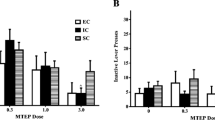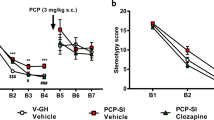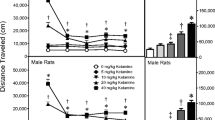Abstract
Rationale
Social interaction during drug exposure can potentiate cocaine reward. Isolation rearing (ISO) during adolescence increases social interaction and may amplify this potentiation.
Objectives
The objectives of this study are to determine whether ISO alters conditioned place preference (CPP) for cocaine when combined with a social cue and to determine whether ISO alters the effects of cocaine when combined with social cue on nucleus accumbens shell (NAcS) dopamine (DA) and serotonin (5-HT).
Methods
Male and female rats were either ISO or group (GRP) reared for 4 weeks during adolescence. CPP was performed using a low dose of cocaine (2 mg/kg or saline) with or without exposure to a novel same-sex conspecific during conditioning. In vivo microdialysis was performed using the same parameters.
Results
ISO rats engaged in more social and aggressive behaviors during conditioning relative to GRP. Cocaine reduced social and aggressive behaviors in all rats. CPP was not influenced by rearing condition. Cocaine produced significant CPP, and a social cue produced CPP only in males. In contrast, the interaction of cocaine and a social cue on NAcS DA and 5-HT differed depending upon rearing condition. In isolates, cocaine-induced DA was attenuated, while cocaine plus a social cue produced potentiated DA and 5-HT.
Conclusions
Exposure to a low dose of cocaine in the presence of a social cue produced additive effects on CPP while producing synergistic effects on DA and 5-HT in the NAcS of ISO rats. The aversive effects of this compound stimulus may negate the rewarding effects in isolates.







Similar content being viewed by others
References
Achterberg EJ, Trezza V, Siviy SM, Schrama L, Schoffelmeer AN, Vanderschuren LJ (2013) Amphetamine and cocaine suppress social play behavior in rats through distinct mechanisms. Psychopharmacology (Berl)
Auclair AL, Cathala A, Sarrazin F, Depoortere R, Piazza PV, Newman-Tancredi A, Spampinato U (2010) The central serotonin 2B receptor: a new pharmacological target to modulate the mesoaccumbens dopaminergic pathway activity. J Neurochem 114:1323–1332
Baarendse PJ, Limpens JH, Vanderschuren LJ (2013) Disrupted social development enhances the motivation for cocaine in rats. Psychopharmacology (Berl)
Bland ST, Twining C, Watkins LR, Maier SF (2003) Stressor controllability modulates stress-induced serotonin but not dopamine efflux in the nucleus accumbens shell. Synapse 49:206–208
Bland ST, Schmid MJ, Watkins LR, Maier SF (2004) Prefrontal cortex serotonin, stress, and morphine-induced nucleus accumbens dopamine. Neuroreport 15:2637–2641
Bland ST, Hutchinson MR, Maier SF, Watkins LR, Johnson KW (2009) The glial activation inhibitor AV411 reduces morphine-induced nucleus accumbens dopamine release. Brain Behav Immun 23:492–497
Calcagnetti DJ, Schechter MD (1992) Place conditioning reveals the rewarding aspect of social interaction in juvenile rats. Physiol Behav 51:667–672
Christianson JP, Paul ED, Irani M, Thompson BM, Kubala KH, Yirmiya R, Watkins LR, Maier SF (2008) The role of prior stressor controllability and the dorsal raphe nucleus in sucrose preference and social exploration. Behav Brain Res 193:87–93
Craige CP, Unterwald EM (2013) Serotonin (2C) receptor regulation of cocaine-induced conditioned place preference and locomotor sensitization. Behav Brain Res 238:206–210
Der-Avakian A, Bland ST, Schmid MJ, Watkins LR, Spencer RL, Maier SF (2006) The role of glucocorticoids in the uncontrollable stress-induced potentiation of nucleus accumbens shell dopamine and conditioned place preference responses to morphine. Psychoneuroendocrinology 31:653–663
Douglas LA, Varlinskaya EI, Spear LP (2004) Rewarding properties of social interactions in adolescent and adult male and female rats: impact of social versus isolate housing of subjects and partners. Dev Psychobiol 45:153–162
Epstein JA, Bang H, Botvin GJ (2007) Which psychosocial factors moderate or directly affect substance use among inner-city adolescents? Addict Behav 32:700–713
Ettenberg A, Geist TD (1991) Animal model for investigating the anxiogenic effects of self-administered cocaine. Psychopharmacology (Berl) 103:455–461
Ettenberg A, Raven MA, Danluck DA, Necessary BD (1999) Evidence for opponent-process actions of intravenous cocaine. Pharmacol Biochem Behav 64:507–512
Ettenberg A, Ofer OA, Mueller CL, Waldroup S, Cohen A, Ben-Shahar O (2011) Inactivation of the dorsal raphe nucleus reduces the anxiogenic response of rats running an alley for intravenous cocaine. Pharmacol Biochem Behav 97:632–639
Ferdman N, Murmu RP, Bock J, Braun K, Leshem M (2007) Weaning age, social isolation, and gender, interact to determine adult explorative and social behavior, and dendritic and spine morphology in prefrontal cortex of rats. Behav Brain Res 180:174–182
File SE, Seth P (2003) A review of 25 years of the social interaction test. Eur J Pharmacol 463:35–53
Floresco SB, West AR, Ash B, Moore H, Grace AA (2003) Afferent modulation of dopamine neuron firing differentially regulates tonic and phasic dopamine transmission. Nat Neurosci 6:968–973
Fone KC, Porkess MV (2008) Behavioural and neurochemical effects of post-weaning social isolation in rodents-relevance to developmental neuropsychiatric disorders. Neurosci Biobehav Rev 32:1087–1102
Fritz M, El Rawas R, Klement S, Kummer K, Mayr MJ, Eggart V, Salti A, Bardo MT, Saria A, Zernig G (2011) Differential effects of accumbens core vs. shell lesions in a rat concurrent conditioned place preference paradigm for cocaine vs. social interaction. PLoS One 6:e26761
Fulford AJ, Marsden CA (2007) An intact dopaminergic system is required for context-conditioned release of 5-HT in the nucleus accumbens of postweaning isolation-reared rats. Neuroscience 149:392–400
Gipson CD, Beckmann JS, El-Maraghi S, Marusich JA, Bardo MT (2010) Effect of environmental enrichment on escalation of cocaine self-administration in rats. Psychopharmacology (Berl) 214:557–566
Green TA, Alibhai IN, Roybal CN, Winstanley CA, Theobald DE, Birnbaum SG, Graham AR, Unterberg S, Graham DL, Vialou V, Bass CE, Terwilliger EF, Bardo MT, Nestler EJ (2010) Environmental enrichment produces a behavioral phenotype mediated by low cyclic adenosine monophosphate response element binding (CREB) activity in the nucleus accumbens. Biol Psychiatry 67:28–35
Hall FS (1998) Social deprivation of neonatal, adolescent, and adult rats has distinct neurochemical and behavioral consequences. Crit Rev Neurobiol 12:129–162
Hall FS, Humby T, Wilkinson LS, Robbins TW (1997) The effects of isolation-rearing on preference by rats for a novel environment. Physiol Behav 62:299–303
Hall FS, Wilkinson LS, Humby T, Inglis W, Kendall DA, Marsden CA, Robbins TW (1998) Isolation rearing in rats: pre- and postsynaptic changes in striatal dopaminergic systems. Pharmacol Biochem Behav 59:859–872
Hatch AM, Wiberg GS, Zawidzka Z, Cann M, Airth JM, Grice HC (1965) Isolation syndrome in the rat. Toxicol Appl Pharmacol 7:737–745
Hermes G, Li N, Duman C, Duman R (2010) Post-weaning chronic social isolation produces profound behavioral dysregulation with decreases in prefrontal cortex synaptic-associated protein expression in female rats. Physiol Behav 104:354–359
Hicks BM, South SC, Dirago AC, Iacono WG, McGue M (2009) Environmental adversity and increasing genetic risk for externalizing disorders. Arch Gen Psychiatry 66:640–648
Howes SR, Dalley JW, Morrison CH, Robbins TW, Everitt BJ (2000) Leftward shift in the acquisition of cocaine self-administration in isolation-reared rats: relationship to extracellular levels of dopamine, serotonin and glutamate in the nucleus accumbens and amygdala-striatal FOS expression. Psychopharmacology (Berl) 151:55–63
Hurst JL, Barnard CJ, Tolladay U, Nevision CM, West CD (1999) Housing and welfare in laboratory rats: effects of cage stocking density and behavioural predictors of welfare. Anim Behav 58:563–586
Johnston AL, File SE (1991) Sex differences in animal tests of anxiety. Physiol Behav 49:245–250
Jones GH, Hernandez TD, Kendall DA, Marsden CA, Robbins TW (1992) Dopaminergic and serotonergic function following isolation rearing in rats: study of behavioural responses and postmortem and in vivo neurochemistry. Pharmacol Biochem Behav 43:17–35
Krebs-Thomson K, Giracello D, Solis A, Geyer MA (2001) Post-weaning handling attenuates isolation-rearing induced disruptions of prepulse inhibition in rats. Behav Brain Res 120:221–224
Kummer K, Klement S, Eggart V, Mayr MJ, Saria A, Zernig G (2011) Conditioned place preference for social interaction in rats: contribution of sensory components. Front Behav Neurosci 5:80
Lapiz MD, Fulford A, Muchimapura S, Mason R, Parker T, Marsden CA (2003) Influence of postweaning social isolation in the rat on brain development, conditioned behavior, and neurotransmission. Neurosci Behav Physiol 33:13–29
Liegeois JF, Ichikawa J, Meltzer HY (2002) 5-HT(2A) receptor antagonism potentiates haloperidol-induced dopamine release in rat medial prefrontal cortex and inhibits that in the nucleus accumbens in a dose-dependent manner. Brain Res 947:157–165
Logan DE, Rose JB (2004) Gender differences in post-operative pain and patient controlled analgesia use among adolescent surgical patients. Pain 109:481–487
Lukkes JL, Watt MJ, Lowry CA, Forster GL (2009) Consequences of post-weaning social isolation on anxiety behavior and related neural circuits in rodents. Front Behav Neurosci 3:18
McCormick CM, Mathews IZ (2009) Adolescent development, hypothalamic–pituitary–adrenal function, and programming of adult learning and memory. Prog Neuropsychopharmacol Biol Psychiatry 34:756–765
Miczek KA, O’Donnell JM (1978) Intruder-evoked aggression in isolated and nonisolated mice: effects of psychomotor stimulants and L-dopa. Psychopharmacology (Berl) 57:47–55
Moller M, Du Preez JL, Emsley R, Harvey BH (2010) Isolation rearing-induced deficits in sensorimotor gating and social interaction in rats are related to cortico-striatal oxidative stress, and reversed by sub-chronic clozapine administration. Eur Neuropsychopharmacol 21:471–483
Morutto SL, Phillips GD (1997) Isolation rearing enhances the locomotor stimulant properties of intra-perifornical sulpiride, but impairs the acquisition of a conditioned place preference. Psychopharmacology (Berl) 133:224–232
Navailles S, Moison D, Ryczko D, Spampinato U (2006) Region-dependent regulation of mesoaccumbens dopamine neurons in vivo by the constitutive activity of central serotonin2C receptors. J Neurochem 99:1311–1319
Panksepp J (1981) The ontogeny of play in rats. Dev Psychobiol 14:327–332
Panksepp J, Herman BH, Vilberg T, Bishop P, DeEskinazi FG (1980) Endogenous opioids and social behavior. Neurosci Biobehav Rev 4:473–487
Paxinos G, Watson C (2007) The rat brain in stereotaxic coordinates, 6th edn. Academic Press/Elsevier
Phillips GD, Howes SR, Whitelaw RB, Robbins TW, Everitt BJ (1994a) Isolation rearing impairs the reinforcing efficacy of intravenous cocaine or intra-accumbens d-amphetamine: impaired response to intra-accumbens D1 and D2/D3 dopamine receptor antagonists. Psychopharmacology (Berl) 115:419–429
Phillips GD, Howes SR, Whitelaw RB, Wilkinson LS, Robbins TW, Everitt BJ (1994b) Isolation rearing enhances the locomotor response to cocaine and a novel environment, but impairs the intravenous self-administration of cocaine. Psychopharmacology (Berl) 115:407–418
Philpot RM, McQuown S, Kirstein CL (2001) Stereotaxic localization of the developing nucleus accumbens septi. Brain Res Dev Brain Res 130:149–153
Rademacher DJ, Schuyler AL, Kruschel CK, Steinpreis RE (2002) Effects of cocaine and putative atypical antipsychotics on rat social behavior: an ethopharmacological study. Pharmacol Biochem Behav 73:769–778
Rosa ML, Silva RC, Moura-de-Carvalho FT, Brandao ML, Guimaraes FS, Del Bel EA (2005) Routine post-weaning handling of rats prevents isolation rearing-induced deficit in prepulse inhibition. Braz J Med Biol Res 38:1691–1696
Schenk S, Hunt T, Colle L, Amit Z (1983) Isolation versus grouped housing in rats: differential effects of low doses of heroin in the place preference paradigm. Life Sci 32:1129–1134
Schenk S, Hunt T, Malovechko R, Robertson A, Klukowski G, Amit Z (1986) Differential effects of isolation housing on the conditioned place preference produced by cocaine and amphetamine. Pharmacol Biochem Behav 24:1793–1796
Schenk S, Lacelle G, Gorman K, Amit Z (1987) Cocaine self-administration in rats influenced by environmental conditions: implications for the etiology of drug abuse. Neurosci Lett 81:227–231
Sfikakis A, Galanopoulou P, Konstandi M, Tsakayannis D (1996) Stress through handling for vaginal screening, serotonin, and ACTH response to ether. Pharmacol Biochem Behav 53:965–970
Skinner ML, Haggerty KP, Fleming CB, Catalano RF (2009) Predicting functional resilience among young-adult children of opiate-dependent parents. J Adolesc Health 44:283–290
Smith MA, Chisholm KA, Bryant PA, Greene JL, McClean JM, Stoops WW, Yancey DL (2005) Social and environmental influences on opioid sensitivity in rats: importance of an opioid’s relative efficacy at the mu-receptor. Psychopharmacology (Berl) 181:27–37
Smith MA, Iordanou JC, Cohen MB, Cole KT, Gergans SR, Lyle MA, Schmidt KT (2009) Effects of environmental enrichment on sensitivity to cocaine in female rats: importance of control rates of behavior. Behav Pharmacol 20:312–321
Spear LP (2000) The adolescent brain and age-related behavioral manifestations. Neurosci Biobehav Rev 24:417–463
Stack A, Carrier N, Dietz D, Hollis F, Sorenson J, Kabbaj M (2010) Sex differences in social interaction in rats: role of the immediate-early gene zif268. Neuropsychopharmacology 35:570–580
Thiel KJ, Okun AC, Neisewander JL (2008) Social reward-conditioned place preference: a model revealing an interaction between cocaine and social context rewards in rats. Drug Alcohol Depend 96:202–212
Tirelli E, Laviola G, Adriani W (2003) Ontogenesis of behavioral sensitization and conditioned place preference induced by psychostimulants in laboratory rodents. Neurosci Biobehav Rev 27:163–178
Trezza V, Damsteegt R, Manduca A, Petrosino S, Van Kerkhof LW, Pasterkamp RJ, Zhou Y, Campolongo P, Cuomo V, Di Marzo V, Vanderschuren LJ (2012) Endocannabinoids in amygdala and nucleus accumbens mediate social play reward in adolescent rats. J Neurosci 32:14899–14908
Tzschentke TM (2007) Measuring reward with the conditioned place preference (CPP) paradigm: update of the last decade. Addict Biol 12:227–462
Vale AL, Montgomery AM (1997) Social interaction: responses to chlordiazepoxide and the loss of isolation-reared effects with paired-housing. Psychopharmacology (Berl) 133:127–132
Varlinskaya EI, Spear LP (2008) Social interactions in adolescent and adult Sprague–Dawley rats: impact of social deprivation and test context familiarity. Behav Brain Res 188:398–405
Wall VL, Fischer EK, Bland ST (2012) Isolation rearing attenuates social interaction-induced expression of immediate early gene protein products in the medial prefrontal cortex of male and female rats. Physiol Behav 107:440–450
Wongwitdecha N, Marsden CA (1995) Isolation rearing prevents the reinforcing properties of amphetamine in a conditioned place preference paradigm. Eur J Pharmacol 279:99–103
Wongwitdecha N, Marsden CA (1996a) Effect of social isolation on the reinforcing properties of morphine in the conditioned place preference test. Pharmacol Biochem Behav 53:531–534
Wongwitdecha N, Marsden CA (1996b) Social isolation increases aggressive behaviour and alters the effects of diazepam in the rat social interaction test. Behav Brain Res 75:27–32
Yajie D, Lin K, Baoming L, Lan M (2005) Enhanced cocaine self-administration in adult rats with adolescent isolation experience. Pharmacol Biochem Behav 82:673–677
Yorgason JT, Espana RA, Konstantopoulos JK, Weiner JL, Jones SR (2013) Enduring increases in anxiety-like behavior and rapid nucleus accumbens dopamine signaling in socially isolated rats. Eur J Neurosci 37:1022–1031
Zakharova E, Miller J, Unterwald E, Wade D, Izenwasser S (2009a) Social and physical environment alter cocaine conditioned place preference and dopaminergic markers in adolescent male rats. Neuroscience 163:890–897
Zakharova E, Wade D, Izenwasser S (2009b) Sensitivity to cocaine conditioned reward depends on sex and age. Pharmacol Biochem Behav 92:131–134
Zhao X, Sun L, Jia H, Meng Q, Wu S, Li N, He S (2009) Isolation rearing induces social and emotional function abnormalities and alters glutamate and neurodevelopment-related gene expression in rats. Prog Neuropsychopharmacol Biol Psychiatry 33:1173–1177
This work was supported by NIH Grant R03DA029673. Dayton Goodell and Cassandra Hayter were supported by NIH undergraduate training grant R25NS080685.
Conflicts of interest
The authors have no conflicts of interest to report.
Author information
Authors and Affiliations
Corresponding author
Rights and permissions
About this article
Cite this article
Grotewold, S.K., Wall, V.L., Goodell, D.J. et al. Effects of cocaine combined with a social cue on conditioned place preference and nucleus accumbens monoamines after isolation rearing in rats. Psychopharmacology 231, 3041–3053 (2014). https://doi.org/10.1007/s00213-014-3470-0
Received:
Accepted:
Published:
Issue Date:
DOI: https://doi.org/10.1007/s00213-014-3470-0




